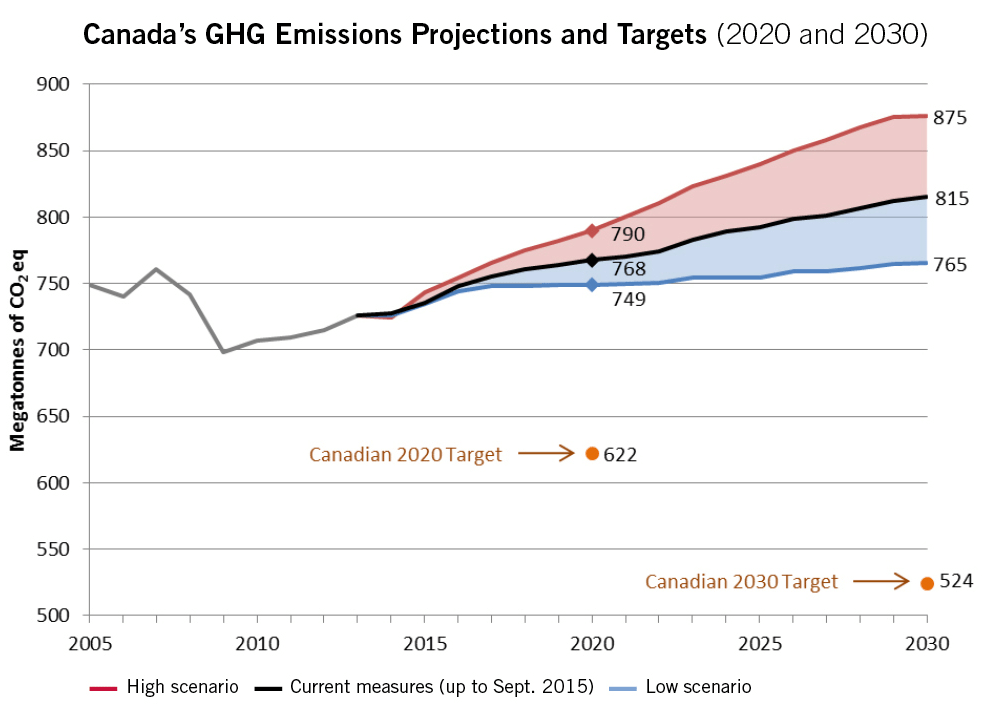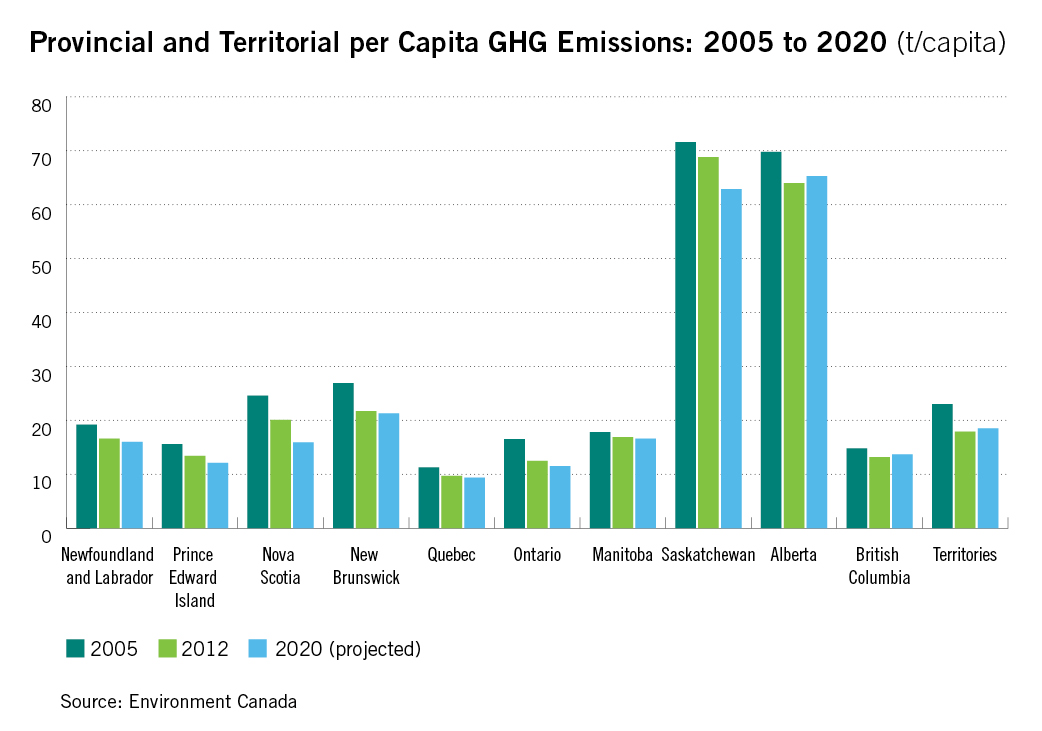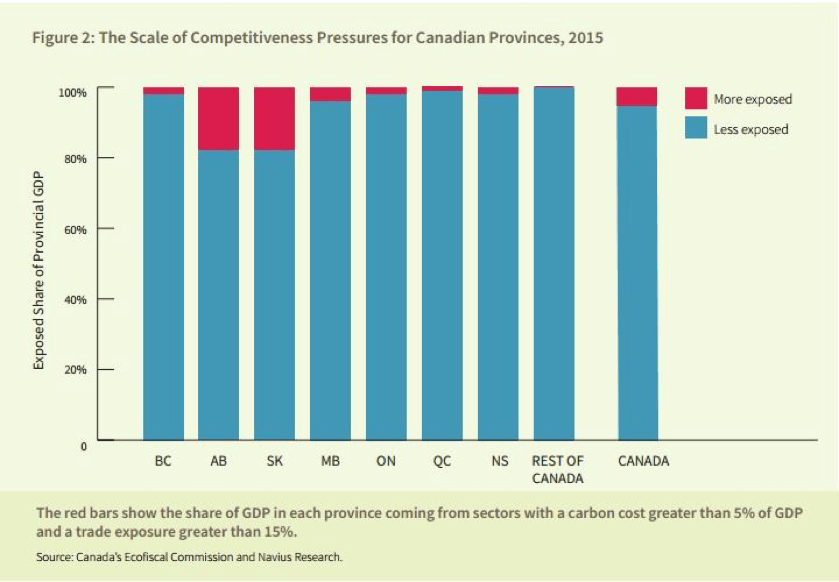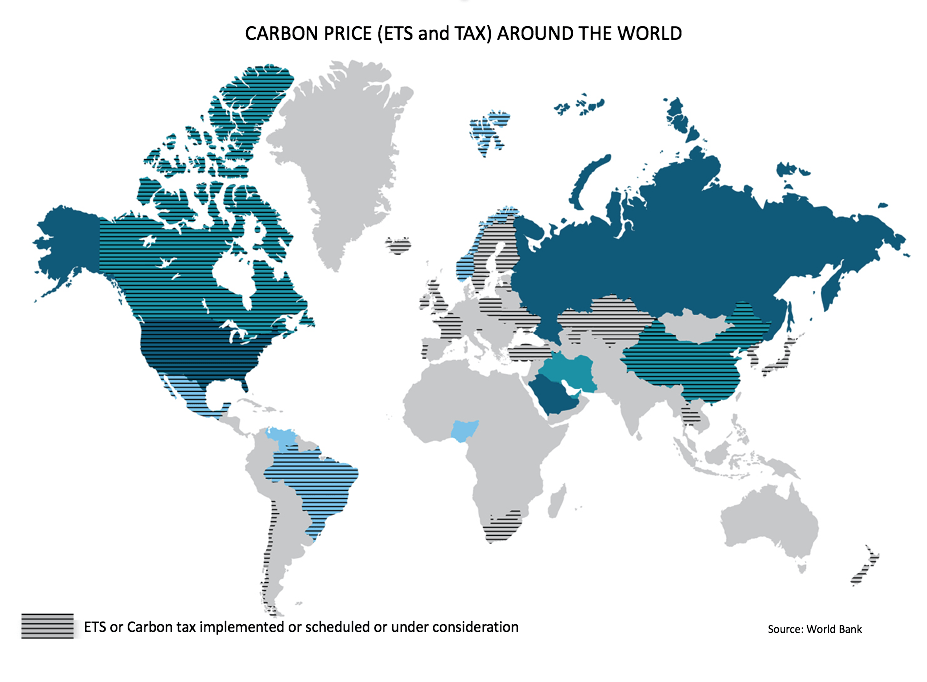On February 4, Trevor McLeod, Director of the Centre for Natural Resources Policy, gave a presentation to the Economic Society of Calgary.
Thank you.
I’m going to take this discussion in a different direction.
We might think – given the state of the Alberta economy, the fact that Prime Minister Trudeau is in town looking to give us money, and our shiny new, ambitious climate plan – that Alberta will not be asked to do more on climate.
We may be wrong!
If Trudeau is serious about meeting Canada’s global environmental commitments, Alberta and Saskatchewan should be very concerned.
In Paris, the Trudeau government agreed to do its part to ensure that global temperatures do not rise more than 2.0C beyond pre-industrial levels (and agreed to try to hold the line at 1.5C). The new government reaffirmed the Conservative government’s target of 30% below 2005 levels but called it the new floor – meaning it might do more.
So, what does this mean? Let’s look at the charts.
This chart – just released by Environment Canada – shows just how hard it will be to meet the Canadian target.
Projections include current actions taken by governments, consumers and businesses, as well as future impact of policies put in place by Sept. 2015 (it doesn’t include the new Alberta plan or Ontario’s cap and trade system).
Alberta’s plan means an additional 20 Mt of reductions in 2020 and additional 50 Mt in 2030, which will get us back to 2013 levels, not 2005 levels (and certainly not 30% below 2005 levels).
We will need to find 190 Mt to eliminate by 2030 (even under the best case scenario).
AND, the 2.0C target and 1.5C target are lower still (off the chart)!
Where will these emissions come from?
This chart shows total GHG emissions in Mt by province. It reminds me of an old Japanese proverb – the nail that sticks up gets hammered.
In total emission terms, Alberta is definitely the nail that sticks up (but Ontario, Quebec, Saskatchewan and BC (LNG) all have reason to be concerned).
Alberta’s climate panel recognized that achieving the Canadian target would be injurious to Alberta.
The per capita story looks equally grim for Alberta and MUCH worse for Saskatchewan. Two nails stick up here. And, since the per capita story is better for Ontario and Quebec, we can expect to hear more about this measure.
So, where are we?
The Canadian discussion has started and battle lines are being drawn.
First Ministers are to lead a process designed to deliver a National Climate Strategy.
Environment Ministers met at the end of January to chart a path toward a National Climate Strategy. The mood was described as “jubilant” – that should give us pause.
Issues have started to take form in advance of the March 2016 First Ministers’ Conference.
The federal government is framing this, largely, as an economic opportunity and trumpeting green transportation infrastructure, clean technology, retrofitted buildings and job creation. This is an urban agenda.
The provincial reaction has been predictable with provinces lining up at the trough. Ontario and Quebec are publicly calling for more money because they took early action to reduce GHG emissions. Alberta and B.C. have been keen to get in on the giveaway. Cities are lining up for money (and are expecting to get it – partly because the vote splits favour money for cities).
As the money is given away (and it seems pretty clear that the federal government is keen to spend the money) it is important to ensure that the investment actually reduces GHG emissions. It is equally important (and this hasn’t received much attention) that the government apply the competitiveness lens – i.e. spending should make us more competitive against competing jurisdictions / we need to be more efficient in getting products to market.
The federal government is also committed to establishing a national carbon price, but it is unclear what it will look like.
The feds have said that they will build on provincial commitments and that they are seeking price consistency across jurisdictions.
This makes sense. The CWF produced a report last year called Patchwork Pollution Solution which argues that provinces should lead on carbon pricing because a one-size-fits-all carbon pricing system does not work for a country with diverse economies. It also shows how we can stitch distinct carbon pricing systems together. It is worth a read.
Prime Minister Trudeau has also said that the federal government will respect provincial jurisdiction – of course, that was before the government announced additional pipeline process that includes consideration of upstream GHG emissions, which (when I studied constitutional and regulatory law) was pretty squarely in provincial jurisdiction.
A cynic could be excused for believing that the federal government plans to use the new pipeline national interest test (including upstream GHG emissions) as a hammer to get Alberta and Saskatchewan to do more to reduce emissions.
Look…. We in the West have seen this movie before. It could get ugly and we need to be prepared.
Alberta has decided to play ball (Notley called the approach “friendly determination”) and has accepted the federal government’s assurances that its intrusion into provincial jurisdiction will help to get pipelines built.
This may work – and I hope it does – but a back-up plan seems prudent.
Saskatchewan has taken a more skeptical approach – asking whether the federal government is also going to look at the GHG emissions profile of cars and planes manufactured in Ontario and Quebec. It is the same argument.
Now is the time for all of us to inject the concept of economic competitiveness concept into the mix.
The Alberta government has now demonstrated that it understands the competitiveness argument.
The climate strategy – which recognized the need to treat energy intensive, trade-exposed industries differently – should be commended for that.
Further, with the royalty review, the government chose not to do a big money grab when sector is down (while incentivizing lower cost structure).
This chart shows that Alberta and Saskatchewan share interests.
The red bars show the share of GDP in each province coming from sectors with a carbon cost greater than 5% of GDP and a trade exposure of more than 15%.
Alberta and Saskatchewan economies are more vulnerable to carbon pricing because we compete with jurisdictions that don’t price carbon. If we price carbon in energy intensive and trade-exposed industries, while our competitors do not, then there will be carbon leakage. That is, other jurisdictions that do not price carbon will get the jobs and Canada will suffer.
Alberta and Saskatchewan should present a united front if they hope to avoid the hammer.
Premiers Wall and Notley will need to bury the hatchet and present a common argument.
It seems unlikely that the NDP Premier of Alberta and the centre-right Premier of Saskatchewan will form an alliance – but there is good precedent. In very difficult times, Saskatchewan NDP Premier Allan Blakeney and Progressive Conservative Alberta Premier Peter Lougheed formed such an alliance – based on mutual interests.
We are having a national climate debate with a very narrow, often parochial focus.
We are looking at a map of Canada and deciding who does what.
Here is the map that really matters for Alberta’s economy.
It shows countries that produce the most oil – shaded according to how much.
It also overlays jurisdictions with existing or announced carbon price and overstates carbon pricing regimes:
This shows all of Canada – really just Alberta. It shows all of US – really just California… Washington and Oregon are under consideration, not Texas, not North Dakota (our competitors).
It shows all of China – currently just some (seven) cities – including Shanghai and Beijing. (Not producing regions).
But, the point remains – this is the map that matters to Alberta and Saskatchewan – not the map of Canada.
Alberta and Saskatchewan need to remind other Canadian jurisdictions that the world is changing around us, and we need to adapt.
First, with the TransPacific Partnership we are losing preferential access to US market – the table for 3 with Mexico and US is becoming a table for 12 (which includes competitors).
We need to develop new markets, not just for oil!!
China wants a trade agreement with us. Publicly they seek access to our oil (pipelines) and the ability to invest in our economy. We need to figure out how we deal with China!
Second, our biggest oil customer is now our biggest competitor.
> 99% of our exported oil is sold to US.
> Meanwhile, the US has become the biggest oil producer in the world.
– US production increased by 4million bbl/day in 4 years (something it took Alberta 70 years to do).
– It built 8,000 miles of pipe in US in last 5 years, yet shuts down XL.
– Oil export restrictions have been lifted.
– The global oil market has been turned on its head and we are seeing the ramifications of that.
To conclude:
We know that we need to more to reduce GHG emissions. But, now is not the time for parochial Canadian debates about who gets what. Now is the time to take the broad view, to put global competitiveness dynamics on the national radar, and make sure this Pan-Canadian Climate Strategy does not hobble the Canadian economy at the worst possible time.





